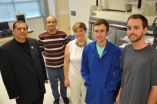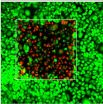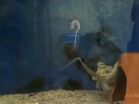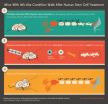(Press-News.org) CORVALLIS, Ore. – The quality of early child care and education programs is influenced both by funding and by the characteristics of the communities in which the programs operate, new research from Oregon State University shows.
The findings indicate that law- and policy-makers may need to consider the demographics of communities when making funding decisions about early childhood programs, said Bridget Hatfield, an assistant professor in OSU's College of Public Health and Human Sciences.
That's especially important now because many states, including Oregon, are adopting or revising quality ratings systems that tie funding to program quality, Hatfield said.
Her findings were published recently in "Early Childhood Research Quarterly." Co-authors were Joanna K. Lower of Lower & Company, Deborah J. Cassidy of the University of North Carolina at Greensboro and Richard A. Faldowski of the University of North Carolina at Chapel Hill. Hatfield received funding for the research from the Institute of Education Sciences at the University of Virginia.
Hatfield studied about 7,000 licensed early child care and education programs in North Carolina, which has one of the nation's oldest quality rating and improvement systems for early child care and education programs. These systems are used by many states to determine how much government funding an early child care and education program receives.
Oregon and many other states are in the midst of implementing a quality rating system.
Hatfield found that children from low-income communities have less access to high-quality early child care and preschool, even though they are likely to gain more benefits from it.
"There are a lot of barriers to high-quality education in disadvantaged communities," she said. "Hiring teachers with bachelor's degrees, providing appropriate school supplies and play equipment – you need money to do all those things."
Her research also showed that additional government funding can provide a significant boost to the quality of programs in disadvantaged communities. Those programs make bigger quality improvements when they receive extra funding than programs that are in more affluent communities, Hatfield found.
"Just because a program is in a disadvantaged community doesn't mean it can't attain high quality," she said. "The extra money helps the programs in disadvantaged communities close the gap."
Hatfield studied family child care homes, where child care is provided in a private home, as well as child care centers and preschool programs, including federal programs such as Head Start.
The research shows that quality of child care can vary based on funding, but other factors also affect program quality, Hatfield said.
For example, in other research projects, she is studying the interactions between teachers and children in the classroom. That kind of research will help child care program leaders determine how best to spend money they receive to improve their programs.
"If we give people more money, what's the best way to spend it?" she said. "Do we buy more puzzles for the children or train the teachers to better use the puzzles they have?"
INFORMATION: END
Study: Targeted funding can help address inequities in early child care programs
2014-05-15
ELSE PRESS RELEASES FROM THIS DATE:
Fires in San Diego County blazing
2014-05-15
The single fire that ignited and split into nine separate fires still blazes in Southern California today. Firefighters are hoping for a break today (Thursday, May 15, 2014) but it doesn't look like luck may be on their side. Conditions continue to be bone dry with unseasonal heat (98-106 degrees) and the Santa Ana winds are kicking up and allowing these fires to easy jump fire lines. This particular fire started on Wednesday as a single fire and within a day is now nine separate fires which have burned close to 10,000 acres. These fires are threatening more than just ...
Giant telescope tackles orbit and size of exoplanet
2014-05-15
Using one of the world's largest telescopes, a Lawrence Livermore team and international collaborators have tracked the orbit of a planet at least four times the size of Jupiter.
The scientists were able to identify the orbit of the exoplanet, Beta Pictoris b, which sits 63 light years from our solar system, by using the Gemini Planet Imager's (GPI) next-generation, high-contrast adaptive optics (AO) system. This approach is sometimes referred to as extreme AO.
The Gemini Planet Imager snapped an amazingly clear and bright image of the gas giant Beta Pictoris b after ...
Detailed studies reveal how key cancer-fighting protein is held in check
2014-05-15
St. Jude Children's Research Hospital scientists have mapped the structural details of how p53 attaches to its regulatory protein, called BCL-xL, in the cell. The protein p53 is a key activator of the cell's protective machinery against genetic damage, such as the mutations that drive cancer cells' explosive growth.
The detailed understanding of how these two molecular puzzle pieces fit together will help scientists design drugs that release p53 in cancer cells, triggering their suicide, called apoptosis.
The findings appear in the current online journal Nature Structural ...
Researchers examine intersection of aging, chronic disease
2014-05-15
A new collection of articles appearing in The Journals of Gerontology, Series A: Biological Sciences and Medical Sciences examine how the basic biology of aging drives chronic disease. Together, they highlight the value of the emerging field of geroscience, which uses an integrated approach to the study of diseases and disability associated with growing older.
Geroscience seeks to bridge the divide between studies of aging and studies of chronic disease, with the hope of understanding their complex relationship and pointing the way to novel interventions for disease, ...
Silly Putty material inspires better batteries
2014-05-15
RIVERSIDE, Calif. (http://www.ucr.edu) — Using a material found in Silly Putty and surgical tubing, a group of researchers at the University of California, Riverside Bourns College of Engineering have developed a new way to make lithium-ion batteries that will last three times longer between charges compared to the current industry standard.
The team created silicon dioxide (SiO2) nanotube anodes for lithium-ion batteries and found they had over three times as much energy storage capacity as the carbon-based anodes currently being used. This has significant implications ...
Going beyond the surface
2014-05-15
BUFFALO, N.Y. – Photodynamic therapy (PDT) is an effective treatment for easily accessible tumors such as oral and skin cancer.
But the procedure, which uses lasers to activate special drugs called photosensitizing agents, isn't adept at fighting cancer deep inside the body. Thankfully, that's changing due to new technology that could bring PDT into areas of the body which were previously inaccessible.
Described May 11 in the journal Nature Photonics, the approach involves using near-infrared beams of light that, upon penetrating deep into the body, are converted into ...
How octopuses don't tie themselves in knots
2014-05-15
VIDEO:
An octopus is treating its own freshly amputated arm in a strange and exploratory manner that is not commonly seen with respect to food items. Note the 'startle' response of...
Click here for more information.
An octopus's arms are covered in hundreds of suckers that will stick to just about anything, with one important exception. Those suckers generally won't grab onto the octopus itself; otherwise, the impressively flexible animals would quickly find themselves all tangled ...
First test of pluripotent stem cell therapy in monkeys is a success
2014-05-15
Researchers have shown for the first time in an animal that is more closely related to humans that it is possible to make new bone from stem-cell-like induced pluripotent stem cells (iPSCs) made from an individual animal's own skin cells. The study in monkeys reported in the Cell Press journal Cell Reports on May 15th also shows that there is some risk that those iPSCs could seed tumors, but that unfortunate outcome appears to be less likely than studies in immune-compromised mice would suggest.
"We have been able to design an animal model for testing of pluripotent ...
Mice with MS-like condition walk again after human stem cell treatment
2014-05-15
(SALT LAKE CITY) - Mice severely disabled by a condition similar to multiple sclerosis (MS) were able to walk less than two weeks following treatment with human neural stem cells. The finding, which uncovers potential new avenues for treating MS, will be published online on May 15, 2014, in the journal Stem Cell Reports.
In striking contrast to active, healthy mice, those with an MS-like condition must be fed by hand because they cannot stand long enough to eat and drink on their own. When scientists transplanted human neural stem cells into the MS mice, they expected ...
Not just a pretty face, although that helps female politicians on election day
2014-05-15
Female politicians' success can be predicted by their facial features, especially in conservative states where women with more feminine faces tend to do better at the ballot box, a Dartmouth College-led study finds.
The results don't mean a supermodel will win the White House, but they do suggest women's electoral success requires a delicate balance between voters' perception of traditional femininity and political competence. The study appears in the journal Social Psychological and Personality Science. A PDF of the study is available on request. Here is a video animation ...




